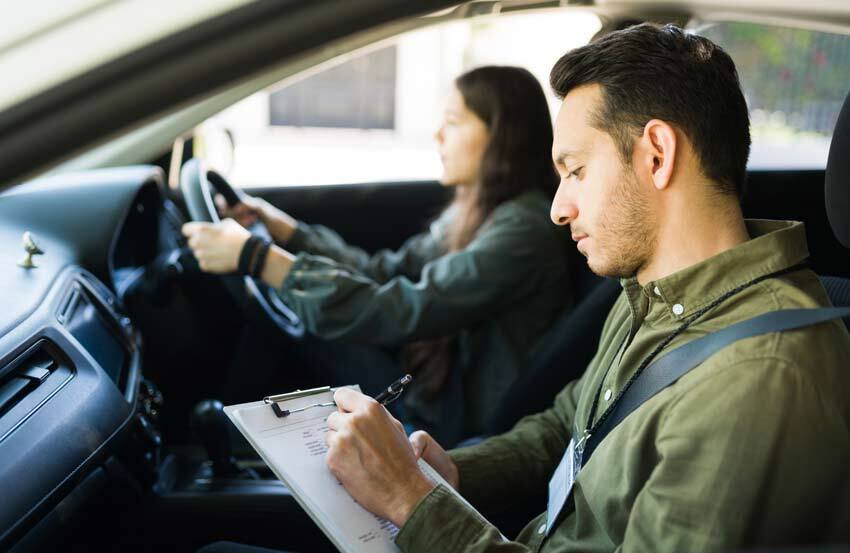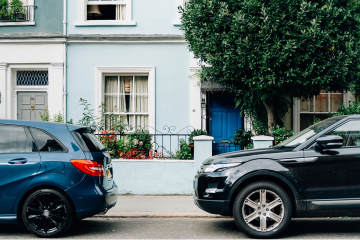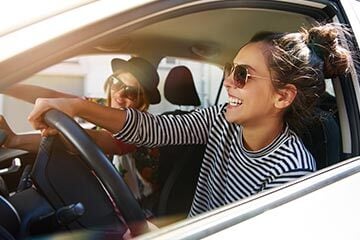Passed your driving theory test? Then it's time to gear up for the practical exam.
Preparing to take your driving test can cause feelings of anxiety and stress. But knowing what to expect can help put your mind at ease.
We're here to make sure you feel as confident as possible when it's time get behind the wheel.

What happens on the driving test?
A driving test is made up of 5 parts:
- An eyesight test
- 'Show me, tell me' vehicle safety questions
- General driving ability
- Reversing your vehicle
- Independent driving
The test is the same for both automatic and manual cars.
The examiner will pick a test route for you, and you'll finish back at the test centre. You'll be driving on various roads in a mixture of traffic conditions. But you won't be asked to drive on motorways.
During your test, your examiner will ask you to pull over and pull away in the vehicle. This includes:
- Normal stops at the side of the road
- Pulling out from behind a parked car
- A hill start
You may also be asked to perform an emergency stop.
Compare car insurance quotes
What manoeuvres will I have to do?
The manoeuvre you're asked to do will depend on the examiner, and varies from test to test. Driving test manoeuvres may include:
-
Parallel parking: Park your vehicle parallel to the road
-
Pulling up on the right: Pull up on the right side of the road, reverse a couple of car lengths, and then rejoin traffic
-
Bay parking: Park in a parking bay, either by driving in and reversing out, or reversing in and driving out
-
Reversing around a corner: Reverse your vehicle around a corner
-
Emergency stop: Stop your vehicle as quickly and safely as possible
-
Turning right at a crossroads: Turn right at a crossroads controlled by traffic lights
-
Turn in the road: Perform a three-point turn
What questions might I be asked?
During the test you might be asked 'show me, tell me' questions about vehicle safety.
'Show me' questions require you to perform a safety task, showing your instructor how it's done.
'Tell me' questions ask you to explain how to perform a safety task.
Examples of a 'show me' question might be:
- How to wash the windscreen
- How to operate the horn
- How to open and close a side window
- How to perform a vehicle safety check
- How to switch on dipped headlights
- How to set the rear demister
For 'tell me' questions, you might be asked:
- How to check the brakes before driving
- How to check the recommended tyre pressure
- How to adjust the head restraint
- How to check the anti-lock braking system (ABS)
- How to check the power-assisted steering
- How to turn on the rear fog lights
- How to check the oil level
- How to check the brake lights
- How to check the direction indicators
How long do driving tests last?
Driving tests usually last for around 40 minutes.
If you've been banned from driving you might take an 'extended driving test.' You'll drive for a longer period of time, usually around 70 minutes.
What do I need to bring with me to my test?
There are a few things you'll need to bring with you on the day of your test, such as:
-
Your UK provisional driving license. If you don't have a photocard license bring your paper license and a valid passport.
- Your theory pass certificate, if you have it.
- A car! Most people use their driving instructor's car for the test, but you're allowed to do the test in your own car. It just needs to meet certain specifications.
How many minors can you have on a driving test?
In the UK, you can get up to 15 minor driving faults on your driving test and still pass.
But if you receive a major fault or three of the same minor fault, you'll fail.
How long does it take to pass your driving test?
In the UK, it usually takes around 45 hours of driving lessons and 22 hours of private practice to pass the driving test.
This can vary from person to person though. Even the location you're taking the test in can determine whether you pass or fail.
Passing your driving test can depend on your confidence, the amount of practice you've had. Everyone has a different learning speed when learning to drive. So don't feel disheartened if you need to take a little longer.
There are some intensive driving courses that are designed to get you ready to pass much faster. An intensive course might save you time if you're looking to get your license quickly. But it all depends on the learner.
Can I take my driving test in my own car?
You can take your driving test in your own car instead of your instructor's. You'll need to make sure it meets the rules though:
Registration and Insurance
You should have proof of valid registration and valid car insurance. You can get specific learner driver car insurance which could be convenient for learning.
Safety Features
Your vehicle’s safety features and main components all need to be functioning and legal.
This includes your:
- Seat belts
- Airbags
- Windscreen
- Windscreen wipers
- Horn
- Headlights
- Brake lights
- Indicators
- Tyres
It’ll also need to have 4 wheels, be able to reach at least 62mph, and weigh no more than 3,500 kg.
And, of course, you’ll need to fit it with L-plates (‘L’ or ‘D’ plates in Wales) on the front and rear.
Extras for the Examiner:
You need to fit your car with an extra interior rear-view mirror for the examiner.
You need to make sure the vehicle has passenger seatbelts and a passenger head restraint for the examiner (slip-on types are not allowed).
Can you change your driving test time?
Yes you can change the time of your driving test up to 6 times for free.
You can change your test up to the time your test starts, but there's a charge if you leave it this late.
You can find an earlier appointment (sometimes called a 'cancellation appointment'). You can also move your test to a later date or change which test centre you take the test at.
If you give less than 3 full working days notice you’ll have to pay again. It's worth noting that Monday to Saturday count as working days but Sundays and public holidays don't.
There are a few exceptions where you can apply for a refund for cancelling your test at short notice. You can find out what extenuating circumstances apply at GOV.UK.
There's a few things you'll need in order to change your test:
- Your UK driving licence number.
- Your driving test reference number or theory test pass certificate number. You can find this on letter you got when you passed your theory test.
- Don't worry if you've lost or misplaced your letter. You can find your theory pass test certificate number at GOV.UK.
What will I be licenced to drive?
This depends on the test you take and the type of driving license you get afterwards. You can check what you're licensed to drive by looking at the categories on your driving license.
If you've taken an automatic driving test, you won't be able to drive a manual car. But if you've passed a manual test, you'll still be able to drive an automatic car.
Vans:
You can drive a van up to 3,500 kg with a standard car driving license. This includes small, medium, and large vans, and vans with up to eight passenger seats.
You might need a category C or D license to drive a van that weighs more than 3.5 tonnes, and you might need a higher category license to tow a trailer with your van.
Plus, you'll need van insurance.
Scooters:
You can drive a scooter with an engine size of up to 50 cc and a maximum speed of up to 50 km/h if you have a category P license.
You can drive a light motorcycle with an engine size of up to 125 cc and a power output of up to 11 kW (14.6 bhp) if you have a category A1 license.
You can find the categories of vehicles you can drive in section 9 of your driving license photocard.
Just remember, you'll need scooter insurance too.







